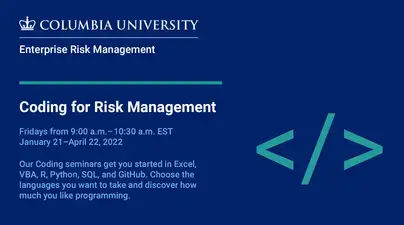Coding for Risk Management, presented by the ERM Program

The Coding for Risk Management seminars get you started in Excel, VBA, R, Python, SQL, and GitHub. The first step in all of these languages is a big step; after taking it here, you will be able to take next steps on your own. These seminars are also a great opportunity to discover how much you like programming. The examples are all related to finance and risk management. In all of the languages we price stocks, bonds, and options. Students who want to take the next step and follow through on this content can enroll in our Coding for Risk Management Class.
How To Join a Session
Click on the Join a Session button at 9:00 am ET on the day of your desired workshop. Each workshop ends at 10:30 am ET.
Workshop info:
Jan 21 | 9:00 to 10:30 am ET
Excel
In our first coding seminar we cover Excel. Excel is an amazing tool widely used for analytics, modeling, trading, and communication. This seminar starts with the basics and quickly moves on to more complicated Excel functions.
Jan 28 | 9:00 to 10:30 am ET
Excel VBA
Excel comes prepackaged with the VBA programming language. VBA is a straightforward programming language. A natural first step to learning VBA and coding in general is to rebuild models that are in Excel. VBA also used Macros to record code based on Excel work. It can teach you to code!
Feb 4 | 9:00 to 10:30 am ET
Intro to R Part 1 of 2
R has some of the most useful and elegant tools including: data frames, ggplot, dplyr, and Shiny. These will be explored later. In this first session of R we begin with the study of different data types in R.
Feb 11 | 9:00 to 10:30 am ET
Intro to R Part 2of 2
In this second session of R we cover data frames and lists. We practice coding in R in a vectorized style.
Feb 18 | 9:00 to 10:30 am ET
Statistics in R
We see how R is built to facilitate statistical work. We explore built in random number generation and we practice manually constructing distributions and comparing them to the built-in versions. We briefly explore multivariate simulation.
Feb 25 | 9:00 to 10:30 am ET
ggplot in R
This week we cover ggplot, the grammar of graphics. ggplot is complicated at first but the payoff is worth the effort. ggplot can be combined with other tools to create interactive visualizations.
Mar 4 | 9:00 to 10:30 am ET
dplyr in R
This week we cover dplyr, the grammar of data. Dplyr is complicated at first but the payoff is worth the effort. dplyr allows for easy manipulation of data and easy to read code. It can be combined with ggplot.
Mar 11 | 9:00 to 10:30 am ET
Shiny in R
Shiny is the simplest and most efficient way to build a website to display your work and data. Shiny can be combined with ggplot and dplyr.
Mar 25 | 9:00 to 10:30 am ET
Python 1 of 3
Python is the most popular language in finance. It has all the power of low level languages and the elegance of high level languages. In this first session, we cover some of the basic data types in Python, lists and dictionaries. We practice by coding up a bond pricing function.
Apr 1 | 9:00 to 10:30 am ET
Python 2 of 3
In our second session of Python, we cover more data types: tuples and sets, and we introduce Numpy and Pandas. We practice by coding up a bond pricing function using Numpy.
Apr 8 | 9:00 to 10:30 am ET
Python 3 of 3
In our last session of Python we explore Object Oriented Programming. We get a feel for how Python is built with objects. We practice by building objects that represent bonds.
Apr 15 | 9:00 to 10:30 am ET
GitHub
This week we introduce GitHub. git is the most popular tool for software version control. That might not sound exciting; but, this tool enables teams to build code together and it has become the world’s repository for code. So, if you want to find code in order to accomplish a task, it’s on GitHub.
Apr 22 | 9:00 to 10:30 am ET
SQL
SQL is the language we use to store and retrieve our data from databases. It is an essential tool that drives our businesses, research, websites, and everything else. We will install SQLite and practice on a sample database.